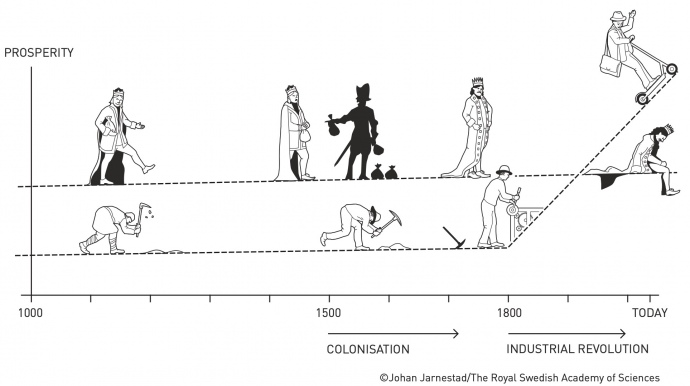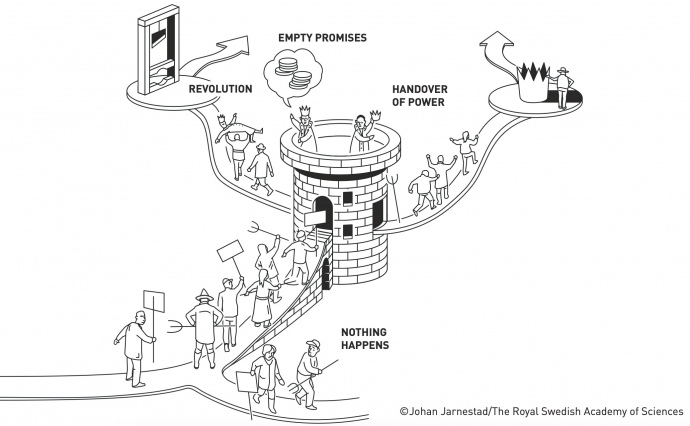Why are some countries poor while others are rich? Nobel Prize-winning economists provide insights into this disparity.
The laureates managed to establish a causal relationship explaining why societies lacking the rule of law and with institutions that exploit the population cannot achieve economic growth. The research is based on the material of colonial exploitation by Europeans starting from the 16th century.
Laureates
In 2024, the award was given to professors Simon Johnson, Daron Acemoglu, and James A. Robinson. The latter two are widely recognized as the authors of the bestsellers "Why Nations Fail: The Origins of Power, Prosperity, and Poverty" and "The Narrow Corridor."
In the first book, the scholars analyze why some countries manage to overcome crises and use them to their advantage, while others decline even without obvious reasons, as well as how much a nation's prosperity depends on geography, history, and governance.
Robinson gained fame for studying the causes and fundamentals of country development. He sought to understand why some states are wealthy while others are poor. He examines economic and political processes in Latin America and Africa.
Acemoglu's research spans a wide range of areas, including economic development and growth, human capital theory, growth theory, innovation, search theory, network economy, and learning.
Johnson is a former chief economist of the International Monetary Fund. His work includes scholarly articles on long-term economic development, corporate finance, political economy, and healthcare.
In collaboration with Acemoglu, Johnson studied the history and economics of major technological transformations, particularly in the field of artificial intelligence.
Why Some Nations Succeed While Others Do Not
The richest 20% of countries are 30 times wealthier than the poorest 20%. Moreover, the income gap between the wealthiest and the poorest nations remains persistent.
"Reducing the vast income disparity between countries is one of the greatest challenges of our time," stated Jacob Svensson, head of the Academy's Committee for the Economic Sciences Prize.
Although the poorest nations have become wealthier over the past decades, they are not catching up with the wealthiest. Why is this happening?
This year's laureates have provided a new explanation for the significant differences in prosperity between nations. A crucial reason is the enduring differences in societal institutions established during the colonization of countries. Acemoglu, Johnson, and Robinson studied the colonization of large parts of the globe by Europeans.
According to the researchers, societies with poor rule of law and institutions that exploit the population do not generate growth or improvements.
The researchers also used data on colonizer mortality and found a correlation: the higher their mortality, the lower the current GDP per capita. They believe that settler mortality (how "dangerous" it was to colonize a territory) influenced the types of institutions created.
Colonial Institutions
When Europeans colonized significant parts of the world, existing institutions sometimes changed drastically, but not uniformly everywhere. In some colonies, the colonizers aimed to exploit the indigenous population and extract natural resources.
One important factor influencing the type of developing colony was the population density of the area to be colonized. The denser the indigenous population, the greater the expected resistance.
On the other hand, a larger indigenous population offered profitable opportunities for cheap labor. This led to fewer European settlers moving to densely populated colonies. In contrast, sparsely populated areas offered less resistance to colonizers and provided less labor for exploitation, resulting in more European colonizers relocating to these less populated areas.
This affected the political and economic systems. When there were few colonizers, they established or took over extraction institutions that focused on benefiting the local elite rather than the broader population.
Conversely, colonies with a large number of colonizers required inclusive economic institutions that encouraged settlers to work hard and invest in their new homeland. This created demands for political rights.
Of course, the first European colonies were not democracies in the modern sense, but compared to densely populated colonies where few Europeans moved, settler colonies provided significantly greater political rights.
This year's award winners demonstrated that initial differences in colonial institutions are a significant explanation for the vast disparities in current prosperity.

For instance, by the mid-18th century, industrial production in what is now India was higher than in the USA. This changed from the beginning of the 19th century. The shift is primarily a result of differences in institutions. Technical innovations that spread worldwide could only take root in places where institutions were created that benefited the broader population.
In the book "Why Nations Fail," the authors provide the example of England, where industrialization occurred despite the resistance of the Luddites (those who opposed technological changes), as the aristocratic opposition was suppressed.
In contrast, industrialization was blocked in the Austro-Hungarian and Russian empires. As a result, the economies of these two empires stagnated. They fell behind other European nations whose economic growth occurred in the 19th century.
Settler Mortality
The type of colonial institutions was explained by the number of European settlers. The more European settlers there are, the greater the likelihood of creating economic systems that promote long-term economic growth.
The professors showed that another factor contributing to institutional differences was the severity of diseases that spread among settlers. For example, diseases present in India were more numerous and dangerous for British colonizers than in New Zealand or Australia.
One reason for this is the extractive institutions that European colonizers either established or chose to maintain if it was beneficial to them, according to the scholars.
The Trap of Extractive Institutions
The inability to provide reliable promises of positive change may also explain why democratization sometimes occurs. When the threat of revolution arises, those in power face a dilemma.
They would prefer to remain in power and try to pacify the masses by promising economic reforms, but the population is unlikely to believe that they will not revert to the old system as soon as the situation is stabilized. Ultimately, the only option may be to transfer power and establish democracy.
"Countries that democratize from a non-democratic regime develop eight to nine years faster than non-democratic regimes. This is a significant achievement, but democracy is not a panacea," – emphasized Acemoglu.

The researchers' model for explaining the circumstances under which political institutions are formed and change consists of three components.
The first is the conflict over how resources are distributed and who has the power to make decisions in society (the elite or the masses).
The second is that the masses sometimes have the opportunity to exert power by mobilizing and threatening the ruling elite.
The third is the commitment problem, which means that the only alternative for the elite is to transfer decision-making power to the population.